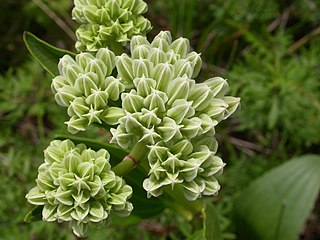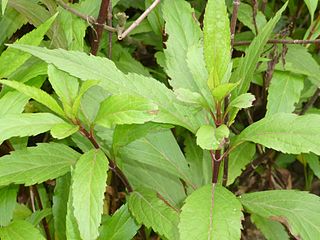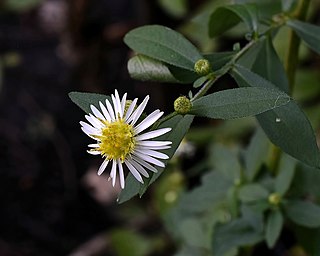
Coreopsis lanceolata, commonly known as lanceleaf coreopsis, lanceleaf tickseed, lance-leaved coreopsis, or sand coreopsis, is a North American species of tickseed in the family Asteraceae.

Coreopsis tinctoria, commonly known as plains coreopsis, garden tickseed, golden tickseed, or calliopsis, is an annual forb. The species is common in Canada, northeast Mexico, and most of the United States, especially the Great Plains and Southern States. It is introduced into many countries in Europe and Asia.

Rudbeckia laciniata, the cutleaf coneflower, is a species of flowering plant in the family Asteraceae. It is native to North America, where it is widespread in both Canada and the United States. Its natural habitat is wet sites in flood plains, along stream banks, and in moist forests. Common names other than cutleaf coneflower include cutleaf, goldenglow, green-headed coneflower, tall coneflower, sochan and thimbleweed.

Eurybia divaricata, the white wood aster, is an herbaceous plant native to eastern North America. It occurs in the eastern United States, primarily in the Appalachian Mountains, though it is also present in southeastern Canada, in the provinces of Ontario, Quebec and Nova Scotia. In the U.S. it is abundant and common, but in Canada it is considered threatened due to its restricted distribution. It has been introduced to a number of countries in Europe. It can be found in dry open woods as well as along wood-edges and clearings. The species is distinguished by its flower heads that have yellow centers and white rays that are arranged in flat-topped corymbiform arrays, emerging in the late summer through fall. Other distinguishing characteristics include its serpentine stems and sharply serrated narrow heart-shaped leaves. The white wood aster is sometimes used in cultivation in both North America and Europe due to it being quite tough and for its showy flowers.

Eurybia is a genus of plants in the family Asteraceae that were previously included in the genus Aster. Most species are native to North America, although one is also present in northern Eurasia. There are 23 species in the genus, including 1 natural hybrid. The name was first applied by Alexandre de Cassini in 1820. The name is derived from Ancient Greek εὐρύς (eurús), meaning "wide", and βαιός (baiós), meaning "few", perhaps in reference to the small number of relatively wide ray florets.

Coreopsis auriculata, the lobed tickseed or mouse-ear tickseed, is a North American plant species of the family Asteraceae. It is native to the southeastern and east-central United States, from Louisiana east to the Florida Panhandle and as far north as Kentucky, Maryland, and West Virginia.

Coreopsis bigelovii is a species of flowering plant in the daisy or sunflower family, Asteraceae, with the common names Bigelow coreopsis and Bigelow's tickseed. It is endemic to California.

Coreopsis maritima, the sea dahlia, is a species of tickseed in the sunflower family.

Arnoglossum plantagineum also known as tuberous Indian-plantain, groovestem Indian plantain or prairie Indian plantain, is a North American species of Arnoglossum in the sunflower family. The Latin specific epithet plantagineum refers to the leaves of the plant which are similar to those of a plantain.

Eupatorium fortunei is a plant species in the family Asteraceae native from Asia where it is rare in the wild but commonly cultivated. The white to reddish colored flowers and herbage smell like lavender when crushed. In China the plants are used to make fragrant oils.

Eupatorium japonicum, known as fragrant eupatorium in English and 白头婆 bai tou po, in Chinese, is a herbaceous plant species in the family Asteraceae. It is native to China, Japan and Korea.

Rafinesquia neomexicana is a species of flowering plant in the family Asteraceae. Common names include desert chicory, plumeseed, or New Mexico plumeseed. It has white showy flowers, milky sap, and weak, zigzag stems, that may grow up through other shrubs for support. It is an annual plant found in dry climate areas of the southwestern deserts of the US and northwestern deserts of Mexico.

Brewerimitella ovalis is a species of flowering plant in the saxifrage family known by the common names coastal miterwort and oval-leaf miterwort. It is native to western North America from southwestern British Columbia, including Vancouver Island, to northern California as far south as Marin County. It grows in moist, shady habitat, such as coastal forests and streambanks.

Coreopsis nuecensoides, commonly known as the Rio Grande tickseed, is a herbaceous, perennial flowering plant in the genus Coreopsis in the family Asteraceae. It is native to southern and southeastern Texas and may also occur in northern Mexico.

Trollius yunnanensis, the Yunnan globeflower, is a species of globeflower, native to southern China; Gansu, Sichuan and Yunnan provinces, and to northern Myanmar. A perennial, it prefers to grow at elevations from 1,900 m up to 3,900 m on grassy slopes and wet meadows. It has gained the Royal Horticultural Society's Award of Garden Merit.

Symphyotrichum ontarionis is a species of flowering plant in the family Asteraceae native to eastern North America. Commonly known as Ontario aster and bottomland aster, it is a perennial, herbaceous plant that may reach heights of 120 centimeters. Each flower head has many tiny florets put together into what appear as one.

Symphyotrichum racemosum is a species of flowering plant native to parts of the United States and introduced in Canada. It is known as smooth white oldfield aster and small white aster. It is a perennial, herbaceous plant in the family Asteraceae. It is a late-summer and fall blooming flower.

Streptanthus cutleri, known as Cutler's jewelflower, is a species of annual flower only found in the Big Bend region of Texas. Its specific epithet and common name both reference Hugh Carson Cutler, who first collected the plant in 1937. A second specimen was later collected when the plant was in fruit, and this holotype was collected at the exact location as the first specimen, in Maravillas Canyon near Black Gap. Its distinguishing characteristic is that only two petals of each its flowers is enlarged.
Coreopsis bakeri, commonly called Baker's tickseed, is a perennial, herbaceous, flowering plant in the Asteraceae family. It is endemic to two counties in northeastern Florida. It is closely related to Coreopsis lanceolata.

Thelesperma simplicifolium, commonly known as the slender greenthread, is a perennial, herbaceous, flowering plant in the Asteraceae family. It is found from Texas and Mexico in openings in oak or juniper woodlands or on desert scrub.



















